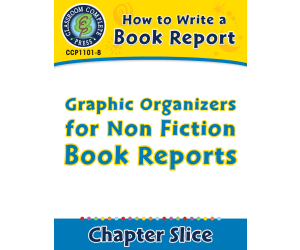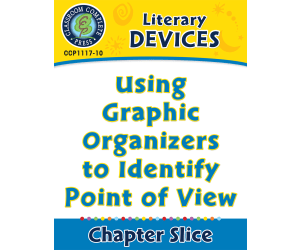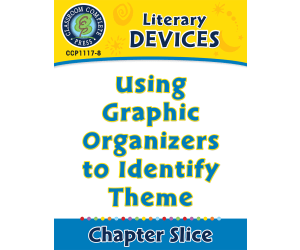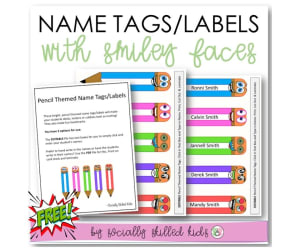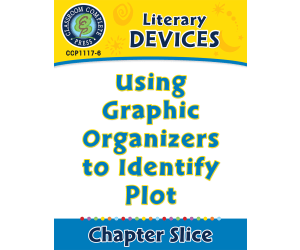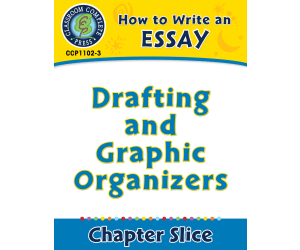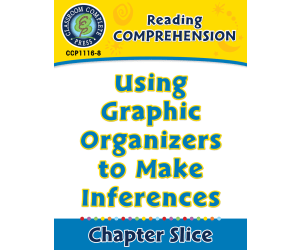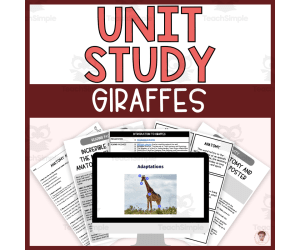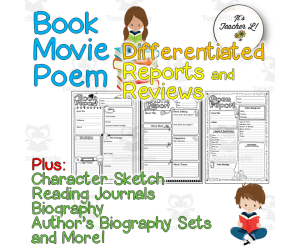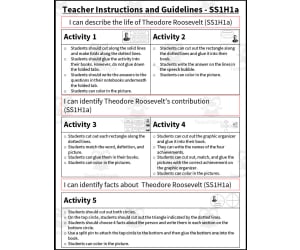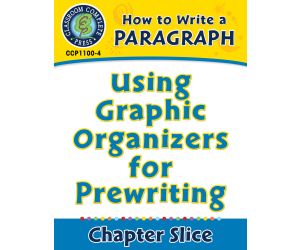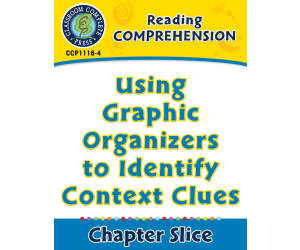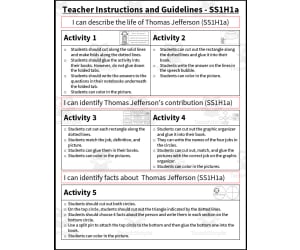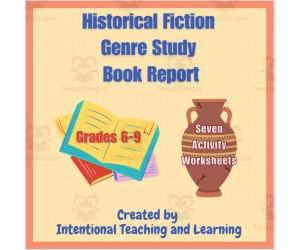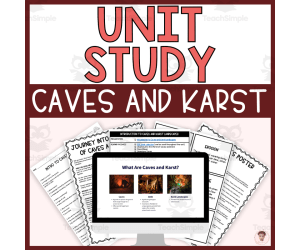3,307 products added recently
Popular Graphic Organizers
Discover a selection of popular graphic organizers suitable for a variety of subjects and grade levels. These versatile tools assist students in structuring information, planning essays, and summarizing content. Utilize these organizers to support critical thinking and improve educational outcomes in your classroom.
How to Write a Book Report: Graphic Organizers for Non Fiction Book Reports
ELA, Writing, Grade 5, 6, 7, 8, Graphic Organizers, Teacher Tools
How to Write a Book Report: Graphic Organizers for Non Fiction Book Reports This teaching resource is an all-in-one solution aimed at engaging both educators and students in the challenging yet exciting endeavor of non-fiction book report writing. Within this comprehensive, 24-page PDF , you'll find all the required tools for helping students in Grades 5 through 8 . The Challenge of Teaching Book Reports Writing Tutors may find it daunting to instruct their pupils on how to craft an efficient book report, and such difficulty tends to increase when dealing with non-fiction content. This instructional tool addresses these concerns directly by furnishing step-by-step guidance supplemented with striking graphic organizers. Focusing on Effective Organization and Presentation This resource concentrates on providing learners with concrete methodologies for collating and displaying information about various non-fiction topics encountered during language arts and writing lessons. Teachers can take advantage of these robust tools to facilitate their students' grasp of organized data management during pre-writing stages. Pupil-Efficient Instructions: The teaching aid combats overcomplicated tasks, presenting clear guidance, inclusive of student assessment rubrics and comprehension quizzes promoting seamless understanding among learners. Bloom’s Taxonomy-Based Objectives: Learning goals follow the globally acclaimed Bloom’s Taxonomy framework encouraging advanced cognition as per current educational standards, aligning perfectly with Common Core State Standards. Vocabulary Skill Reinforcement: Ready-to-use word puzzles serve as entertaining interludes while amplifying vocabulary learnt from textbooks, infusing an air of fun into learning activities without compromising educational guidelines. Potential Use Cases across Classroom Activities Educators can choose from multitude options regarding this tool's application. It can be used in numerous techniques ranging from whole-class instructions to small group discussions, outside classroom activities and even individual self-pacing exercises! Concluding Thoughts In essence, tutors seeking engaging methodologies to instruct non-fiction book report writing will find immense value in this aid. The perfect blend of explicit teaching, captivating graphic organizers and extensive student guides makes it a crucial addition to any toolkit. Applying such resource promises simplified yet systematic learning experiences ensuring efficiency at mastering non-fiction book reporting skills.
Author Classroom Complete Press
Tags Language Arts, Writing, Writing A Book Report, Non-fiction Test, Graphic Organizers
Literary Devices: Using Graphic Organizers to Identify Point of View
ELA, Literature, Grade 5, 6, 7, 8, Graphic Organizers, Teacher Tools
"Literary Devices: Using Graphic Organizers to Identify Point of View" - A Dynamic Lesson Plan Tailored for educators, this resource focuses on teaching students about the fascinating interplay between language and storytelling. It is particularly useful for grades 5 through 8, fitting seamlessly within Language Arts curricula. The tool introduces learners to the intense world beneath mesmerizing tales—the Literary Devices . These include critical components like: Characterization Setting Plot Theme, and more... The value in this resource lies in its emphasis on identifying Point of View in literature via grade-specific activities utilizing graphic organizers. User-friendly Definitions and Practice Opportunities- Apart from providing simple definitions for key terminologies, it offers repeated practice opportunities to bolster understanding. Bloom's Taxonomy Model Adherence- The content adheres strictly to the Bloom's Taxonomy model ensuring high quality and educational validity making it usable in both public schools or homeschools alike. It could be used with whole class cohorts or smaller study groups; not forgetting homework assignments either. Tying narrations together with age-appropriate learning activities enable young scholars to understand storytelling better while appreciating creativity; they also build critical analysis skills tackling diverse literary forms encouraging exploration that growth-seeking academic minds desire. Thus whether you aim at arming young minds for expansive literary studies or just inspire a deep affection toward classic/modern Literature - 'Literary Devices: Using Organizers Identify Point of View' could be an indispensable addition to your teaching toolkit.
Author Classroom Complete Press
Tags PDF, Graphic Organizers For Literature, Literary Element Lesson Plans
Literary Devices: Using Graphic Organizers to Identify Theme
ELA, Literature, Grade 5, 6, 7, 8, Graphic Organizers, Teacher Tools
Literary Devices: Using Graphic Organizers to Identify Theme Target Audience: Educators in the field of Language Arts and Literature The " Literary Devices: Using Graphic Organizers to Identify Theme " is a flexible and well-structured teaching resource. An extension of the comprehensive lesson plan titled "Literary Devices," this product promotes an investigative approach toward examining storytelling techniques. About this Resource: - This 24-page printable PDF helps demystify theme identification using graphic organizers. - It provides multiple opportunities for students from grades 5 to 8, encouraging them to practice and improve their story analysis skills. This resource delves into detailed understanding of reading beyond rudimentary levels. It covers: Characterization Setting Plot Theme Point-of-view alongside foreshadowing and flashback. Inclusive Features: The module includes explanatory definitions for significant terms, aiding both students' as well as teachers' understanding. Versatility & Adaptability Useful in diverse settings, it can be administered as part of whole group lectures or utilized during small study groups teachings. Also suitable for homeschooling environments. The guide's structure, optimized using Bloom’s Taxonomy of Learning structures ensures educational viability. This aids not only with teaching but with guiding students on how to employ these literary devices themselves while analyzing various literature types. User-friendliness: This guide is exceptionally user-friendly aimed at simplifying rather than complicating your task at hand—teaching! Credibility & Conformity Its alignment with Common Core State Standards underlines its credibility and assists educators across different systems without hampering content fluidity or structure integrity. Final Word: This guide is your next narrative journey partner, where meaning surfaces upon careful scrutiny. You can enable your learners rightly equipped with tools to decode and appreciate the 'building blocks' of compelling tales.
Author Classroom Complete Press
Tags Plot, Theme, Point Of View, Literature, Graphic Organizers, Literary Graphic Organizer
33 editable BOOKMARKS for students and teachers "Nature"
, Not Grade Specific, Teacher Tools, Graphic Organizers
33 editable BOOKMARKS They were designed for ANY CLASS, ANY SUBJECT, ANY GRADE, ANY LANGUAGE. These 33 BOOKMARK templates can be used by the teacher and the students. My students really love to create their own bookmarks ! All you have to do is edit the bookmarks with text, links, QR codes, photos, clipart, graphics and more - and then print ! Content: 33 templates to use year after year 11 slides with different layouts for each bookmark 3 bookmarks / slide Lines for easy cutting The text boxes were already made for you - you can add more and move them where needed. How to use: Use them as presents for Christmas, Easter, Back to school, spring, Earth Day, Thanksgiving, birthdays, school trips, parents, night... for ANY OCCASION ! Provide reading tips, useful expressions... punchcard bookmarks, library bookmarks, vocabulary, grammar, operation, revision bookmarks... Have your students write or type poems, notes... for their classmates, parents, teachers... The possibilities are endless ! Format : PowerPoint Add text, clip art images, shapes, photos, drawings, charts, graphics, QR codes, tables… Copy / paste your notes, lessons, directions, activities… or type original text. Choose your fonts, your colors, your sizes… Save as pdf and print the size you like Please note : The clip art images used in this resource belong to their owners and are not editable (background, frames and clip art images). For similar resources and engaging activities for your students, visit my page HERE !
Author Pick'n Teach
Tags Graphics, Editable, Nature, Bookmarks, Reading
Pencil Themed Smiley Face Name Tags
, Not Grade Specific, Classroom Decor, Teacher Tools, Graphic Organizers
Fun and colourful pencil themed name tags/labels will make your students desks, lockers or cubbies look so inviting!
Author Socially Skilled Kids
Tags Name Tags, Labels, Pencil Theme
Literary Devices: Using Graphic Organizers to Identify Plot
ELA, Literature, Grade 5, 6, 7, 8, Graphic Organizers, Teacher Tools
Literary Devices: Using Graphic Organizers to Identify Plot This is an invaluable educational resource designed for teachers and homeschooling parents alike. The material stimulates immersive learning through engaging content and targets students in Grades 5 to 8. Product Features: A comprehensive overview of vital literary devices such as characterization , setting , plot structure , theme development , and point of view . Necessary concepts like foreshadowing, flashback techniques, symbol usage, and irony are also included. The unique emphasis on using graphic organizers helps students recognize plot structures effortlessly. This approach improves visual processing skills while simultaneously developing critical thinking abilities. A user-friendly layout with easily comprehensible definitions coupled with multiple skill practice opportunities ensures a high degree of learning efficacy. The resource aligns impeccably with Bloom's Taxonomy learning objectives as well as Common Core State Standards demonstrating academic relevance - making it a preferred choice for any educator planning literature studies programs. Pack Includes: An easily printable PDF file consisting of 24 pages full of innovative lesson plans that will engage your students holistically in understanding the nuances of story structure. In short, this resource enables learners to analyze complex literary components confidently. Its utility extends beyond classroom teaching – encompassing group study sessions or individual homework assignments – labeling it a multifaceted pedagogical companion.
Author Classroom Complete Press
Tags Graphic Organizers, Language Arts, Story Elements, Plot, Point Of View
How to Write an Essay: Drafting and Graphic Organizers
ELA, Writing, Grade 5, 6, 7, 8, Graphic Organizers, Teacher Tools
How to Write an Essay: Drafting and Graphic Organizers - A Valuable Educational Tool This remarkable teaching resource is a highly recommended tool for educators committed to enhancing the writing skills of their students. Contained within are 24 printable pages in PDF format , offering meticulously designed lessons that focus on essay writing suitable for Grade 5 through Grade 8 students. Ease of Learning Moving from drafting, refining language skills, unto effectively applying graphic organizers – it covers everything. Utilizes engaging and interactive methods rather than traditional instruction. Bases its educational foundations on Bloom’s Taxonomy, enabling higher order learning. Rich Content & Versatility Suitable for training in various formats such as narrative essays or persuasive articles along with comprehensive grammar exercises. Serves as standalone material or supplementary resource with inbuilt assessment rubrics & comprehension quizzes tailored perfectly to fetch maximum results. 'How to Write an Essay: Drafting and Graphic Organizers' caters excellently whether implemented in whole class sessions or addressing individual needs, making it an indispensable guide for daily classroom activities or strategic lesson planning. The Added Edge - Graphic Organizers The six colorfully designed graphic organizers not only add vibrancy but serve as crucial roadmaps guiding students towards creating well-structured compositions. Positioned appropriately within the Common Core State Standards framework besides being rooted at varying Bloom's taxonomy levels - this ensures holistic education becomes almost intuitive! Your Ultimate Goal Achieved Easily! If you're an educational professional committed to inspiring your students and fostering creativity and critical thinking skills, this tool would prove invaluable. It succeeds in emboldening young minds to exceed the mediocre, embracing a world of creativity and analytical discourse.
Author Classroom Complete Press
Tags Writing An Essay, Drafts, Graphic Organizer, Writing Process, Language Arts
Reading Comprehension: Using Graphic Organizers to Make Inferences
ELA, Reading, Reading Comprehension, Grade 5, 6, 7, 8, Graphic Organizers, Teacher Tools
Reading Comprehension: Using Graphic Organizers to Make Inferences A specialized teaching resource aimed at bolstering reading and comprehension skills of students. Primarily beneficial to educators catering to the 5th Grade through 8th Grade, dealing with the subject area of Language Arts focusing on comprehension. Effective Teaching Tool This product equips teachers with tools to effectively foster critical thinking in their pupils while enhancing their understanding and manipulation of various language forms. It is versatile enough for different instructional methods including whole group lessons , small group activities , or as a homework assignment . Main Features Focusing on building blocks of reading such as using context clues, determining main idea and understanding inferences. Including definitions of key terms along with ample practice opportunities for easy understanding. User-friendly approach making it accessible for all. Bloom’s Taxonomy Approach & Common Core Standards Adherence The teaching material aligns its objectives via Bloom’s taxonomy, leading not only knowledge acquisition but also encouraging comprehensive understanding by applying higher order thinking skills such as analysis and synthesis. In addition, this product's alignment with Common Core State Standards ensures top-notch educational outcomes backed by nationwide accepted benchmarks. Digital Delivery & Practicality This resource is digitally delivered in PDF format allowing convenient accessibility anytime, anywhere. The aim is simple - enhancing student's overall reading competence-a valuable skillset crucial beyond academic life!
Author Classroom Complete Press
Tags PDF
Giraffe Unit Study
Creative Arts, Art, ELA, Reading, Reading Comprehension, Grammar, Language Development, Vocabulary, Spelling, Writing, Science, Life Sciences, Animals, Human Body, Biology, Grade 3, 4, 5, Activities, Crafts, Teacher Tools, Lesson Plans, Presentations, Graphic Organizers, Projects, Assessments, Worksheets & Printables, Worksheets
Giraffe Unit Study The Giraffe Unit Study presents a captivating method to both introduce and expand students' understanding about giraffes. This ready-to-go unit study is structured primarily for elementary teachers and homeschooling parents, enhancing students' knowledge of giraffes through interactive activities. Targeted Learning Styles & Diverse Topics The unit throws light on varied topics such as interactions between giraffes and other species, human impact on their population, scientific research etc which in turn nurtures curiosity in kids. Online presentations with pre-recorded voiceovers for visual and auditory learners Reading passages for bookworms Note-taking pages integrated with graphic organizers for the writers at heart are some of the formats used. Crafting sessions encourage creativity while learning about these fascinating creatures. Inclusive Lessons & Additional Resources All lessons are shaped keeping differential learning styles in mind therefore increasing inclusivity among all students irrespective of their cognitive abilities. The curriculum is further enriched with: Vocabulary word cards paired with dictionary work, Comprehension worksheets from various reading passages, Discussion questions following each lesson as well as regular assessments to keep track of student's comprehension skills. Cross-Curricular Subjects & Scientific Insights Included! The hands-on activities like crafting not only demand active participation but also creatively connect Art (drawing), English language arts along with geography - all seamlessly woven together! It also introduces key scientific topics such as anatomy & physiology providing valuable insights into giraffe adaptations because every learner deserves to know how unique these grassland inhabitants are! The exploration into conservation and scientific research is a cherry on top! Fuel for Imagination & Independent Thinking The avenues of usage include group exploration outdoors, small group discussions, individual homework assignments or even co-reading sessions. The possibilities are limitless! With the Giraffe Unit Study, every aspect has been carefully planned out with each young learner's academic journey at the heart because education should never be mundane and it won't be, thanks to this unit.
Author Heather Huhman
Tags Giraffes, Unit Study, Interactive Activities, Science Education, Conservation Efforts
Truman and the Dropping of the Atomic Bomb: Graphic Organizer
Social Studies, History, History: USA, Grade 8, 9, 10, 11, Teacher Tools, Graphic Organizers
Harry S. Truman, the 33rd President of the United States, played a pivotal role in the development and use of atomic bombs during World War II. Truman assumed the presidency on April 12, 1945, following the death of President Franklin D. Roosevelt. At that time, the Manhattan Project, a secret research program focused on developing atomic weapons, was already underway. As President, Truman was faced with a difficult decision regarding the use of atomic bombs against Japan. The Manhattan Project had successfully created two atomic bombs, and Truman had to decide whether to deploy them as a means to end the war. After the war, Truman focused on preventing the spread of nuclear weapons. He supported the creation of the United Nations and played a key role in establishing the Baruch Plan, which proposed international control of atomic energy to prevent further proliferation. Truman's decision to use atomic bombs on Hiroshima and Nagasaki remains one of the most consequential actions of his presidency. It ushered in the nuclear age, shaped the course of history, and sparked ongoing discussions about the use and ethics of atomic weapons. Teacher-prepared notes show students what is important and how ideas relate, and offer a model for how students should take notes themselves (Marzano et al., 2001). This graphic organizer gives students two primary source quotes regarding Truman's use of the bomb. The notes then explain some pro/con arguments about the use of the bomb. Lastly, the notes give students a chance to look at the six immediate effects of the bomb. Comes with a fill-in-the-blank version. Clipart Credit: By PrincePadania
Author Dr. Will Pulgarin
Tags World War II, Truman, Atomic Bomb, Manhattan Project, Japan, Cold War, Graphic Organizer, Pro Con Graphic Organizer
Book, Movie, Poem Differentiated Reports, Reviews AND MORE!
ELA, Strategies, Language Development, Vocabulary, Writing, Grade 4, 5, 6, Teacher Tools, Graphic Organizers, Activities, Worksheets & Printables, Worksheets
This Book, Movie, Poem Differentiated Reports and Reviews is a set of 23 pages graphic organizers no-prep worksheets that are designed for primary level learners, ESL/EFL students and homeschoolers. The worksheets are made to accompany reading and writing activities that will help learners better understand the contents of their class lessons. Aside from the worksheets that can help students record and report about the books, movies, and poems that they are learning, this resource also includes reading journals, character sketch, biography, author’s biography, and vocabulary log worksheets, as well as book reading and movie tracker worksheets. The graphic organizers are amazing tools to use, guide and gauge the students’ grasp of the lessons and help the learners take control of their own learning. Additionally, this set includes differentiated activities to cater to different level of learners. Contents: Movie Reports Movie Reviews Movie Tracker Book Reports Book Reviews Book Reading Tracker Poem Reports Poem Reviews Reading Journals Character Sketch Worksheets Biography Worksheets Author’s Biography Worksheets Vocabulary Log Worksheets Applications: 1. Supplemental tools for book reading, movie analysis, and poem study lessons. 2. Can be used as assessment tools, homework and projects. 3. Perfect inclusion to students’ portfolios. 4. Research practice activities. 5. Teacher-emergency tool.
Author It's Teacher L
Tags Book Review, Book Report, Movie Review, Movie Report, Poem Review, Poem Report, Biography, Authors Biography, Vocabulary Log
Theodore Roosevelt Interactive Notebook | SS1H1a, SS1H1b, SS1G1a, SS1CG1
Social Studies, Biographies, Preschool, Grade 1, 2, Teacher Tools, Graphic Organizers
This resource is a Theodore Roosevelt Interactive Notebook. There are 17 activities included. All you have to do is print and go. Students will enjoy these activities during social studies units.
Author Sarah Miller Tech
Tags Theodore Roosevelt, Interactive Notebook, Graphic Organizers, Social Studies, Cut And Paste
Literary Devices: Using Graphic Organizers to Identify Setting
ELA, Literature, Grade 5, 6, 7, 8, Graphic Organizers, Teacher Tools
Literary Devices: Using Graphic Organizers to Identify Setting This all-encompassing educational tool focuses on the vital elements of literature such as setting, plot, theme, point of view, foreshadowing and flashback, symbolism and irony . It is not just about offering clear-cut definitions but also providing enough practice opportunities for students. Using Graphic Organizers to Identify Setting This chapter guides students in understanding how settings can define stories. By using graphic organizers – a form of visual learning -, students get better at storing information making it easier to decipher the significance of setting within a literary work. Suitability & Use This product caters follower wide range - whether executed in whole groups or small groups or given as homework. The aim here is ensuring that it adapts best according to your classroom requirements. Structured Learning: This resource aligns with Bloom’s Taxonomy of Learning ensuring its educational pertinence and efficiency. Ready-to-use: Comprising 24 pages that are ready-to-print which are contained within a single PDF file allow for convenient usage without any extra provisions needed. Matching up with Grade 5 to Grade 8 grade levels’ Common Core State Standards - this tool ensures strict adherence towards meeting expectations related to Language Arts focusing specifically on Literature subdomain. Creative Narration & Interactive Activities: The blend of engaging narration styles accompanied by involving activities like interpretation symbols or identifying storylines using graphic organizers ensures student's deep understanding about storytelling fundamentals. When you wish for improving your student's literature assessment skills effectively while having fun during that process then Literary Devices: Using Graphic Organizers To Identify Setting * proves itself as an exceptionally profitable addition. Not only does it add to their knowledge but also creates an intrigue about language arts.
Author Classroom Complete Press
Tags Language Arts, Literary, Literature, Graphic Organizers, Word Search
How to Write a Paragraph: Using Graphic Organizers for Prewriting
ELA, Writing, Grade 5, 6, 7, 8, Graphic Organizers, Teacher Tools
How to Write a Paragraph: Using Graphic Organizers for Prewriting This is an essential educational resource to enhance students' writing proficiency. In this chapter, the focus is on the use of graphic organizers for prewriting, with a step-by-step guide aimed at simplifying the writing process and enhancing language arts skills. Homeschool educators and public school teachers alike will find great value in using this tool. It serves as an excellent supplement to existing reading programs and even stands well as independent student work - making it beneficial whether used with a whole class, small groups or given as homework assignments. This resource encourages thought articulation through well-crafted sentences and paragraphs – something crucially significant for students in Grades 5 through 8. The four main types of paragraph forms introduced through this lesson plan are based on Bloom’s Taxonomy learning objectives. Makes writing logical yet easy-to-understand Offers multiple opportunities for maximized efficiency during the prewriting phase using various graphic organizers Six color graphic organizers are included that not only define skill focus but assist learners navigate their way meticulously through words Detailed Implementation Guide & Additional Extras: A comprehensive implementation guide, in PDF form, is provided within this product file offering tips on incorporating it effectively into your teaching cycle – so you can invest more time in instructing rather than planning! Plus word puzzles elevate the fun element in education alongside a comprehension quiz meant at subtly but accurately assessing understanding level. Assessment Rubric: An assessment rubric tailored considering student performances assists objective grading while remarkably meeting Common Core State Standards as well aligning perfectly with Bloom's Taxonomy. Cements learning outcomes making this product How to Write a Paragraph: Using Graphic Organizers for Prewriting a sought-after asset in pedagogy.
Author Classroom Complete Press
Tags PDF
Habit Trackers: Building Responsibility at Home
Life Studies, Home Economics, Preschool, Grade 1, 2, 3, 4, 5, 6, 7, 8, 9, 10, 11, 12, Teacher Tools, Graphic Organizers
Empower Your Family with Habit Trackers: Cultivating Responsibility Together Unlock the Power of Responsibility with 11 Unique Tracker Options for Your Home! Key Learning Goals: Discover pivotal habits that nurture and enhance responsibility Monitor progress while nurturing these habits Foster a supportive family dynamic A Glimpse of What Awaits: Embark on a journey of personal growth as a family unit by setting achievable goals to fortify existing habits and forge new ones! Inside this package, you'll find an array of habit trackers meticulously designed to foster responsibility within the household. Plus, there's room for personalization! Check Out our Tracker Customization Tips Tailoring trackers fosters a sense of ownership, agency, and enthusiasm for reaching milestones! Once objectives are set, every family member is encouraged to endorse their chosen habit tracker. Browse through an assortment of ready-to-use Home Responsibility Habit Trackers, along with blank weekly and monthly templates that seamlessly adapt to any habit your family wishes to prioritize. Embark on a joyful journey of setting and conquering goals together, commemorating achievements, and standing united during challenges as you pave the way for lasting habits. Tips for customizing habit trackers: Personalize it with a: drawing favorite character goal Take it one day at a time, week at a time, or month at a time! Adjust the number of habits to focus on
Author Sprout & Inspire
Tags Responsibility, Life Skills, Laundry, Chores, Chore Chart, Character Education, Habits
Reading Comprehension: Using Graphic Organizers to Identify Context Clues
ELA, Reading, Reading Comprehension, Grade 5, 6, 7, 8, Graphic Organizers, Teacher Tools
Reading Comprehension: Using Graphic Organizers to Identify Context Clues An extraordinary teaching resource that shines light on a crucial element of reading comprehension - understanding context clues via graphic organizers. This tool - a part of the extensive Reading Comprehension lesson plan, nurtures vital reading skills enhancing both fluency and comprehension across diverse situations. Leveraging children's natural knack for consuming written content, this educational aid propels them towards academic prosperity and life expertise. In today's world, evolving into adept readers is an important communication talent catered to by this informative guide which presents basic stepping stones towards advanced reading skills effectively. The resource expounds on important yet challenging concepts such as: Harnessing context clues, Determining main ideas, Building inferential skills All these elements are conveyed in a learner-friendly style facilitating quick grasping. The material provides numerous opportunities for honing these key abilities through varied practice sessions spaced across the content. Educators would find the adherence of this unique tool to Bloom's Taxonomy to be highly commendable — there are structured educational objectives maintaining pedagogical appropriateness while also aligning with Common Core State Standards. Definitions provided for important terminologies encourage better understanding and vocabulary development — another compelling feature setting this resource apart from others. This tool has been meticulously crafted catering specifically Grade 5-8 students immersed in Language Arts studies', focusing especially on comprehension aspects. Its versatility allows integration into group instructions or smaller study groups or even individual assignments serving as enriched homework tasks strengthening school-learnt concepts. The comprehensive package includes: A PDF file detailed lesson plans simplifying teaching maneuvers—beneficial for both public school educators integrating classroom lessons or homeschoolers wanting guidance on delivering structured academic content.
Author Classroom Complete Press
Tags PDF
Thomas Jefferson Interactive Notebook | SS1H1a, SS1H1b, SS1G1a, SS1CG1
Social Studies, Biographies, Preschool, Grade 1, 2, Teacher Tools, Graphic Organizers
Thomas Jefferson Interactive Notebook Bring Thomas Jefferson and early American history to life for students with this engaging social studies resource. This interactive notebook invites kids to immerse themselves in Jefferson's world through 17 skill-building activities. Learners will create timelines, map Jefferson's travels, analyze famous speeches and documents he authored, and more. The notebook covers key first grade social studies topics like basic economics and American symbols and holidays. Use it to teach standards SS1H1a, SS1H1b, SS1G1a, and SS1CG1. This printable packet allows students to actively process new information on Jefferson. Pair these materials with a biography and primary sources on America's third president. Differentiate instruction by using the notebook for whole-class learning, small groups, or independent practice. Get creative - the possibilities are endless!
Author Sarah Miller Tech
Tags Social Studies, Thomas Jefferson, Graphic Organizers, Venn Diagram, Presidents
Historical Fiction Genre Study Book Report
Social Studies, ELA, Reading, Reading Comprehension, Literature, Grade 6, 7, 8, 9, Worksheets & Printables, Novel Studies, Teacher Tools, Graphic Organizers, Activities, Projects, Lesson Plans, Assessments, Worksheets
The 34-page Historical Fiction Genre Study Book Report is designed for grades 6th, 7th, 8th, and 9th, but it can easily be modified for lower or higher grades. This book report is an excellent supplement to a unit on a particular historical period. Through reading historical fiction, students can gain a deeper appreciation for historical periods and how they relate to the present day. The goal of this lesson is to introduce students to the genre of historical fiction and to help them understand its importance and significance. By the end of the lesson, students should have a good understanding of what historical fiction is. Students will read a historical fiction novel, analyze its characters, plot, and author's craft, and present their findings to a small group. The book report includes a detailed lesson plan on the historical fiction genre, objectives and learning targets aligned to the Common Core standards, directions for the book report with handouts and worksheets for students, a student self-evaluation, and a grading sheet for teachers. Many students enjoy reading historical fiction, especially if they are learning about the period in their History/Social Studies class. If you do the genre study component of this resource, the book report offers a high-quality culminating project. In addition, if you teach a Language Arts/History Core or plan with a History/Social Studies partner-teacher, this is an excellent resource for both classes and provides students with a different way to engage with history. Historical fiction is an essential genre for students for a variety of reasons because it makes the study of history more engaging and interesting and it brings the past to life. Students gain a deeper appreciation for historical periods and how they relate to the present day, It also improves critical thinking skills by giving students opportunities tothink critically about the events and people from the past, analyze and interpret historical events, understand different perspectives,and it encourages empathy, tolerance, and respect because students learn to see history through the eyes of characters from different time periods and cultures Historical Fiction Genre Study Book Report includes the following: 2 comprehensive and interactive lesson plans: Book Browse lesson plan Historical Fiction Genre lesson plan with common core standards, objectives, and learning targets easy-to-follow student directions Note taking Guide Note taking Guide Chart Spoke Diagram Plot Diagram Character Chart Sensory Description Chart Other Elements in Historical Fiction Chart Storyboard Presentation in Small Groups Directions Self-Evaluation of Historical Fiction Book Report Check-Off and Grading Sheet Other Resources You Might Be Interested In: Book Reports: Autobiography/Biography Genre Study Book Report and Speech Book into Movie Project: Compare and Contrast Book Report and Essay Book Jacket Book Report Character Analysis Essay, Gift for a Character Book Report, and Oral Presentation Historical Fiction Genre Study Book Report Historical Fiction Genre Study Literature Circle Project Poetry Book Report Mini-Reviews Book Report Mystery, Thriller, Horror, and Suspense Genre Study Book Report Narrative Nonfiction Genre Study Book Report Project Poetry Book Report Dystopian. Science Fiction, and Fantasy Genre Study Game Board Project Reading Units: Creating Independent Readers in your Middle School Classroom which is available as 1 unit or as individual resources Part 1: What We Do When We Read: Part 2: Reading Logs, Setting Goals, and Reflection Part 3: Summary Writing for Short Stories Part 4: Metacognitive Logs: Reading Response Bonus: How to Set Up An Amazing Classroom Library (without Spending Much Money): Google Slide Shows: Characterization: What It Is and How to Develop It Writing with Suspense If you have any questions, please email me at gruenwaldy1@gmail.com
Author Intentional Teaching and Learning
Tags Historical Fiction, Book Report, Research, Assessment, Story Elements, Analysis, History, Author's Craft, Critical Thinking, Self-evaluation
Year of Graphic Organizers
ELA, Writing, Grade 5, 6, 7, 8, 9, 10, Teacher Tools, Graphic Organizers
Year of Graphic Organizers: Your Ultimate Language Arts Assistant Year of Graphic Organizers is an all-inclusive teaching resource tailored for educators in order to streamline the learning process. This diverse collection is highly beneficial in public school contexts as well as homeschooling setups and can be easily integrated into different group settings whether it's a whole class, small clusters or individual homework assignments. With this collective treasure of graphic organizers, the missing piece from a comprehensive Language Arts curriculum puzzle will finally fit. The beauty of these collaborative tools lies within their ability to kindle engagement, and stir imagination while fulfilling the enjoyment aspect that makes learning more effective for students. Sharp learners or ones still finding their groove will equally benefit due to its rich array catering to various comprehension levels. The Importance and Utility of Graphic Organizers Graphic organizers are pivotal - they are visual facilitators simplifying knowledge intake and retention for children enabling them faster understanding of facts and concepts. Moreover, they accelerate practical knowledge application by allowing learners to visualize connections between facts which ultimately helps in meaningful knowledge absorption. Included Resources: Persuasive Writing Organizers, Expository Writing Organizers, Vocabulary Organizers, Book Report Forms, Etc... Futher resources range from Rough Draft Forms catalyzing ideation process followed by nurturing structure via Final Draft Activities leading up till Timelines that teach charting capabilities effectively! Outlining becomes less daunting with ready-made forms accompanied by grading rubrics ensuring fair appraisal representation. New Additions? Always Complementary! The Year of Graphic Organizers doesn’t end here! It’s an ever-growing resource so any new additions are complementary benefits already included within your purchase making it optimal cost-effective educational assistance material. Targeted at Grade 5 through Grade 10 learners specializing in Language Arts; applicable contextually not only within Middle School or Upper Elementary but equally useful for Special Ed Classrooms. This bundle as PDF students will experience how graphic organizers can turn Language Arts into a picturesque learning journey that's enjoyable as it is informative.
Author Socrates Lantern
Tags Graphic Organizers, Teaching Resource, Language Arts, Engagement, Learning Tools
The Antebellum South: Graphic Organizer
Social Studies, History, History: USA, Grade 7, 8, 9, 10, Teacher Tools, Graphic Organizers
The Antebellum South: Graphic Organizer The Antebellum South: Graphic Organizer is a vital teaching resource designed to aid educators in imparting students with an intuitive understanding of the complex societal, economic, and cultural facets of the pre-Civil War era in the Southern United States. This tool proves particularly beneficial for Grade 7 to Grade 10 educators dealing with social studies. Key Features: Insightful Understanding : Alongside explaining topics like slavery and socio-economic division prevalent in the antebellum south, this resource also provides insights into cotton and tobacco - cash crops extensively farmed on plantation farms using enslaved Africans. All-encompassing narrative : This graphic organizer weaves together crucial events such as Nat Turner's rebellion while tracing debates sparked by southern leaders justifying slavery based on economic compulsions which simultaneously raised discussions around racial hierarchy and states' rights. (Refer to appended teacher notes) Versatility : Suitable for whole-class discussions, group activities or assigned as individual research work due to its self-explanatory design. Tailored Resources: Presented in PDF format, The Antebellum South: Graphic Organizer includes both a teacher-prepared notes variant complete with comprehensive explanations and a student variant that promotes self-learning. Note: The uniqueness lies in this tool's succinct yet informative approach – allowing grades 7-10 students to effectively grasp historical contexts without compromising on factual integrity solely aimed at enhancing their educational pursuits. As an added bonus, thumbnail clipart supplied by Clip Art Emporium makes it visually engaging. Not requiring additional software or resources adds icing on the cake – just print it out and you're all set! Encoded with rich education values, this ready-to-use tool indisputably becomes a wonderful addition to any classroom.
Author Dr. Will Pulgarin
Tags Antebellum South, Graphic Organizer, Social Studies, Slavery, Plantation Farms
Literary Devices: Using Graphic Organizers to Identify Characterization
ELA, Literature, Grade 5, 6, 7, 8, Graphic Organizers, Teacher Tools
Literary Devices: Using Graphic Organizers to Identify Characterization Literary Devices: Using Graphic Organizers to Identify Characterization is a vital teaching resource, particularly useful for educators aiming to undertake an in-depth analysis of language used in storytelling. This content section emphasizes on applying graphic organizers to pinpoint character definition, forming part of the full lesson plan known as "Literary Devices". Crafted for students between grades 5 and 8 studying Language Arts and Literature, this product offers clear meanings of key narrative tools. It elucidates how characterization shapes stories by demystifying abstract ideas through structured literary systems. These detailed graphic organizers aids students in understanding the formation of characters in various works of literature. The resource provides ample practice opportunities about characterization. Every element included aligns perfectly with Bloom’s Taxonomy of Learning , thus ensuring efficient achievement of educational goals. Components: The Literary Devices resource dissects other essential elements such as setting, plot, theme, point of view, foreshadowing and flashback symbolism apart from irony - all fundamental ingredients that create a compelling storyline. User-friendly recourse consists one PDF file that contains 24 ready-to-print pages chock-full with narration synced with age-appropriate learning activities offering multiple ways to incorporate them into your teaching schedule; either as whole group lessons or divided among small groups or as individual homework assignments. Aligned With Standards: In agreement with Common Core State Standards guidelines, this tool aims not just at fostering understanding among learners but also cultivating appreciation for building blocks underlying good literature work. By endowing deeper comprehension levels regarding characterization and other literary devices beyond simple text reading which would enable them extract more profound meaning and purpose from all genres of literature.
Author Classroom Complete Press
Tags Language Arts, Graphic Organizers, Characterization, Writing Tasks, Crossword Puzzles
Graphic Organizers: Building Comprehension Skills
ELA, Reading, Reading Comprehension, Grade 1, 2, Graphic Organizers, Teacher Tools
Graphic Organizers: Building Comprehension Skills Graphic Organizers: Building Comprehension Skills is a powerful teaching tool designed to augment language arts comprehension for grade 1 and grade 2 students. This resource uses 30 unique and adaptable graphic organizers , making it ideal for both public school instruction and homeschooling. It focuses on essential literature elements like characters, plot, setting, language, story structure, and informational text. . If a comprehensive tool to enhance young readers' understanding of text in thorough detail is your need - this could be your perfect solution. Apart from boating 30 primary templates; it comes with an additional 100 formats. These are combined into a single PDF packing a total of 211 easily printable pages, , ready to instantly bring versatility into any classroom environment or home-based learning set up. Apart from being named 'Graphic Organizers: Building Comprehension Skills', its usage extends beyond organizing graphics - serving as both an introductory instrument towards previously mentioned aspects as well as one that gradually sharpens these foundational skills over time. Possible Benefits & Implementation: This resource could stimulate active student engagement when used in working groups or inspire profound discussions during whole-class sessions. Could serve supplemental support post direct teaching session. An ideal candidate for engaging homework assignments providing hands-on practice on literary comprehension! In Summary: 'Graphic Organizers: Building Comprehension Skills' , offers learners consistent interaction with practical tools that tap their potential while shaping them into competent readers capable of analyzing any given text confidently and extensively. What's offered within one accessible product, has multiple benefits across different contexts, significantly contributing towards progressive learning outcomes! Integrating this highly effective teaching tool into your lesson planning process can enhance instructional effectiveness and boost the discovery journey of young word explorers navigating through language arts comprehension!
Author Classroom Complete Press
Tags Graphic Organizers, Comprehension Skills, Reading Worksheet, Story Plot, Book Companions
Circles Graphic Organizers
Math, Algebra, Geometry, Grade 9, 10, 11, 12, Teacher Tools, Graphic Organizers
If you are a high school math teacher, finding resources that best serve for your students is of the utmost importance! This is a Circles Graphic Organizer Packet that is filled with purposeful information that your students can use right away. Graphic organizers have always been a great way to organize information, so these are no exception! There are 7 sheets included and 2 different versions. You will get one version with blanks, so students can fill in the answer. The other version will not have blanks, so the statements and descriptions will already be complete. You will also get an editable version that you can open in PowerPoint or Google Slides if you want students to complete it digitally. Sheets included: 1. Areas and Arc Lengths of Circles 2. Arc Measures of Circles 3. Segments formed with Circles 4. Angles formed with Circles 5. Inscribed & Circumcised 6. Angles, Arcs, & Chords in a Circle I hope you enjoy! Here are similar resources for you to enjoy: https://teachsimple.com/product/arkansas-river-float-activity https://teachsimple.com/product/fill-the-tank-activity https://teachsimple.com/product/algebra-2-word-wall https://teachsimple.com/product/intro-to-calculus-word-wall You can visit my storefront here: https://teachsimple.com/contributor/smith-math I can be contacted for questions and concerns at smithmathtpt@gmail.com .
Author Smith Math
Tags Circles Graphic Organizers, Smith Math, Geometry Printable, Chords In A Circle, Polygons, Central Angles, Arc Measures, Circumference
Caves and Karst Unit Study
Creative Arts, Art, Social Studies, ELA, Reading, Reading Comprehension, Grammar, Language Development, Vocabulary, Spelling, Writing, Grade 3, 4, 5, Activities, Crafts, Teacher Tools, Lesson Plans, Presentations, Graphic Organizers, Projects, Assessments, Worksheets & Printables, Worksheets
The Caves and Karst Unit Study This is an engaging , comprehensive, and low preparation teaching resource that explores the fascinating world of caves and karst. It is a valuable resource for educators focusing on grades 3 to 5, as well as homeschooling guardians. Main Topics Covered Introductory concepts about caves and karst formations Detailed insight into speleothems and cave forms Landscape found in karsts Particularly captivating information about cave ecosystems habitat adaptations. The unit study wraps up with an exploration of cave conservation efforts highlighting their importance. Tailored Approach to Learning Styles Each lesson includes: Visual-auditory online presentations , alongside curated videos. Reading passages: To cater for those who learn best through perusing textual information. Upon consideration for student handwriting skills levels, options are made available within note-taking pages with either primary lines, regular lines or no lines. Note-taking pages & Graphic organizers: To keep track of acquired knowledge across every topic covered. Hands-on activities are incorporated into every lesson plan providing kinesthetic opportunities. Purposeful Assessment through Quizzes A tool that teachers or homeschoolers can use flexibly over days or weeks depending on pacing preference - quizzes filled with 15 multiple-choice questions per lesson – ideal in testing understanding at each stage. Cross-Curricular Subjects Integration The unit study covers: Art (emphasis on drawing, coloring & crafts) English Language Arts Geography and Geology Grammar, History, Reading, Science and Social Studies research work , Spelling . The Caves and Karst Unit Study: An interactive unit study that inspires young geologists' minds while encouraging the application of learned concepts through hands-on activities. The resource spans over 150 pages premium content in a downloadable file in PDF format. A truly comprehensive guide for both educators and homeschoolers.
Author Heather Huhman
Tags Caves, Karst Formations, Speleothems, Cave Ecosystems, Conservation Efforts






